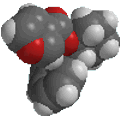 |
Chapter 13: Spectroscopy |
 |
Getting Structures from Spectra
Good problem solving skills are often based on
a good method of attack. Here is some general advice of how to go about determining
structures from spectral data, be it from real spectra of an experimental sample,
or in the context of a question. The order of events here works towards
using the H-NMR at the last stage since it is potentially the most useful for
"assembling" the structure.
However, at each stage it is a good idea to use information in other spectra
(if available) to seek support your interpretation or address any doubts. Try
to get a molecular formula at the earliest possible opportunity
and then calculate the index of hydrogen deficiency
(IHD).
- MS
- determine the molecular weight
- identify the presence of isotopes patterns for Cl or Br
- UV
- is the system conjugated ?
- IR
- identify the functional groups that are present
- 13C-NMR
- how many types of carbon ?
- what types of carbon ?
- H-NMR
- how many types of hydrogen ?
- how many of each type ?
- what types of hydrogen ?
- how are they connected ?
|
Having completed an analysis of the available spectra,
- list the pieces that have been identifed
- check the pieces the MW and / or molecular formula and refine the
pieces to fit
- assemble the pieces paying particular attention to H-NMR chemical
shifts and coupling patterns
|
Once you think you have the answer, check it with the H-NMR very carefully...
it is probably the most critical test to pass.